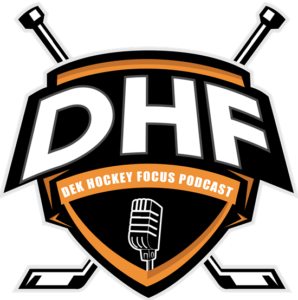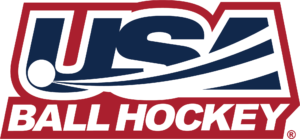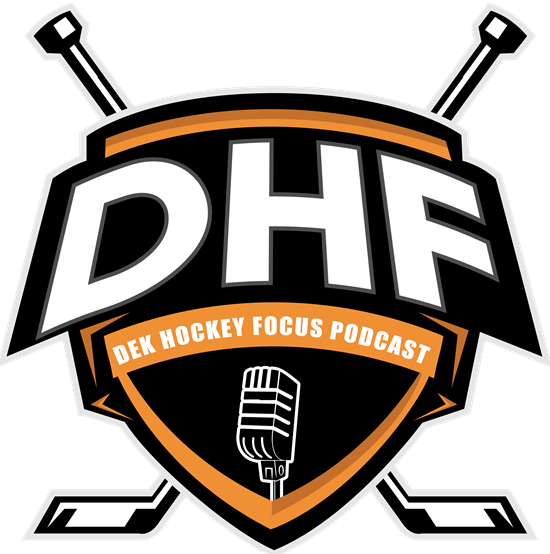Dek Hockey Focus
FOCUSING ON “DEK HOCKEY FOCUS”
AN EXCLUSIVE INTERVIEW WITH THE GUYS WHO DO EXCLUSIVE INTERVIEWS
 For the East Coast ball hockey community, Dek Hockey Focus came on to the scene a little over 2 years ago and have been covering all major club and international 5-on-5 tournaments. They’ve been providing us with insightful interviews from major figures within the game, as well as immediate postgame interviews with players who just stepped off the rink. However, the guys at DHF have been at this for a while, covering a different style of ball hockey for much longer out in the Midwest… 3-on-3.
For the East Coast ball hockey community, Dek Hockey Focus came on to the scene a little over 2 years ago and have been covering all major club and international 5-on-5 tournaments. They’ve been providing us with insightful interviews from major figures within the game, as well as immediate postgame interviews with players who just stepped off the rink. However, the guys at DHF have been at this for a while, covering a different style of ball hockey for much longer out in the Midwest… 3-on-3.
Dek Hockey Focus consists of a 3-man production team; Hosts Eric Mock and Ryan Shackleford in front of the camera, and jack-of-all-trades technician Sean Clark behind it.
We appreciate the fellas taking some time to answer some questions we had about how they got started and what the ball hockey community is like out in the “Hawkeye State.”
How did you guys all meet and how did the Dek Hockey Focus podcast come together?
Sean: I met the majority of the guys through Dek hockey once it was started in the QC. I moved around the country for work a few times before ending back up in Iowa. When I did make it back to Iowa, though, I’d try to hang out and help out with recordings as much as I could. Really, the podcast was a great way to get together, drink beer, and have fun outside the rink.
Eric: The hockey community in the QC (Quad Cities) is very tight knit so the 3 of us have played with and against each other for years. Chad Kennelly originally had the idea for a ball hockey centered podcast. Shack and I are ball hockey fanatics, so it made sense to invite us to weigh in on the topics of the day. Since then, it’s all been a blur.
Ryan: We all met through dek and being at the rink. The hockey community here is close and we all met through playing on different teams, forming new teams and building our relationship from there. DHF was actually not our idea and was started as the brainchild of Chad Kennelly and Michael Holst. They thought of having a medium to talk about the local hockey community and started broadcasting after Friday night games. From there I stepped into a broadcast during the NDA 3-on-3 Summer Tournament and Mock soon joined. Sean was moving around the country for work but when he was in town would join us. From there it has evolved to what we see today.
For those just being introduced to DHF… how would you describe your show?
DHF: We want to be the voice of the game. There are so many amazing personalities, talent and excitement in the sport we simply strive to provide an outlet to support its growth. Our show is our take on what is going on within the game. From major tournaments to individual interviews, our goal is to be that outlet for our sport and provide our take on what is happening all around us.
What are some of the most memorable moments for the show?
Sean: I would say that just about every interview we have done has been memorable in some way. I have to say, though, that Dan Coldwell’s interview was one of our first “Big” interviews. It ended up rolling into two episodes and I feel like it put us on the map. If it wasn’t for everyone that takes the time to interview with us, though, we wouldn’t be able to do what we do.
Eric: My most memorable was last year at the Club Championships. I never thought when we started this, I would be interviewing Alex Burrows.
Ryan: Honestly, I do not know if I can pinpoint any specific memory or event. For me, the most memories I will have is from the relationships we have developed in the sport. I cannot think of one interview we have done that has been a one off discussion, we remain in contact and routinely connect on the sport and life. If I did have to pinpoint one memory though, it would be at the 2019 Club Championships, watching Mock present two college scholarships from USA Ball Hockey and announcing Terri Milby’s award for volunteer of the year.
Now that you have branched out into covering 5-on-5 along with 3-on-3, how do you see DHF evolving over the next couple of years?
DHF: We definitely did not see us on the path we are on now from where we started. We think the future is bright but need to develop a strategy for growth and expansion. Right now we are only a couple of guys in Iowa who are trying to cover the world. Like the adage says, ‘It takes a village’ and ideally we would be able to branch out to regional correspondents to offer more in-depth and local coverage. We are having conversations about how to grow alongside the sport but the sky’s the limit.
When did organized ball hockey get introduced in Iowa and how fast has it grown?
Sean: Organized ball hockey was brought to the Quad Cities from Patrik Levesque in 2012. Coming from an inline and ice hockey background, I remember second-guessing the game. Shack ended up having me sub in a game and I was hooked. The way that Patrik runs the leagues makes it very competitive and fun regardless of what experience you had previously. When it first started, there were 2 divisions with a total of maybe 20 teams. Now there are 12 Adult divisions with over 90 teams and 5 Junior divisions.
Eric: I think QC Dekhockey started in 2012. Honestly I looked down on the game at first. Now I’m absolutely obsessed. It’s gone from 1 rink with 2 divisions, now to multiple rinks and more than 10 divisions. That’s not including the youth leagues, women’s leagues, and national summer tournament. It’s incredible.
Ryan: Ball Hockey came to the Quad Cities in 2012. Pat Levesque was playing for our local professional team at the time and settled in the Quad Cities after he retired. Being from Quebec he was introduced to the game on his trips back home and decided to bring the sport to Eastern Iowa. Sean and Mock hit the highlights on the expansion but for me personally, it reignited my passion for hockey. Prior to dek I had stopped playing for almost 10 years; the first time I stepped onto the rink I was hooked and have gone all in ever since.
What is the atmosphere like there during one of the large summer tournaments?
DHF: Words cannot describe the atmosphere at the NDA National Championship. We call it ‘The Best Weekend of the Summer’ and ‘Tent City’ as teams and players from all across North America converge on Bettendorf, Iowa for 5 days of dek hockey. Crow Creek Park becomes a mixture of college football tailgates and playoff hockey with over $20,000 in cash and prizes on the line. The best way we can describe it is to reflect on those who have been there. 2019’s tournament brought the Southwest (Toronto) Cowboys to compete in the open division. During one of their games we were standing next to one of the player’s wives. After she filmed a panorama picture of the crowd to send back home, we had to ask what she was doing. She explained that the crowd and atmosphere is the best she has ever experienced at any tournament. So much so, she had to send the imagery back home for them to understand.
When teams come to Iowa in July, they always come back!
Every sport has its superstars… who are some of the names to watch in the 3v3 world?
DHF: That is a tough question! Last year the 3-on-3 U16 and U18 put themselves on the map, bringing home medals in Montreal. Some names that stood out to us in that tournament would have to be the ‘Jersey Boys.’ Jack Gallens, JoJo Mellilo and Mike Marchese transitioned from the 5-on-5 game to the 3-on-3 game without skipping a beat and their talent showed.
Carter Schadler, at 14 years old, played up a level and was our pick as the tournament’s top goaltender. Luke Wareham introduced himself to the world stage and has found a spot with the 5-on-5 USA team. Honestly, we could name countless more names but do not want to miss anybody. The key, in our view, is the crossover between 3-on-3 and 5-on-5 and how we collectively align to bring USA Ball Hockey to the next level!
You recently played in a 5-on-5 tournament in Chicago… What are some of the biggest differences in the 2 formats?
DHF: The biggest thing we realized was the concept of space. 3-on-3 is tight, split- second decisions with the opportunity to score from anywhere. 5’s was a more collective strategy and possession. Team play is a huge component. With 3’s there are only 9 people on the roster so you learn to play with your linemates and understand each other. In 5’s you have to account for the larger surface and additional personnel. Overall the strategy and execution between the two styles is completely different.
Breakouts, neutral zone play, defensive alignments and offensive possession are similar in thought but different in execution.
Whether it is 3-on-3 or 5-on-5, it’s the love of hockey that gets us on the rink… where does DHF want to see our sport go in the next decade?
Sean: There are so many places that this could go. I’d love to see ISBHF pick up a 3v3 tournament. I also think with the inception of the NBHL, you will see growth throughout the country. Like everything, though, growth will come from the youth playing the game. I would love to see the NBHL succeed and grow not only it’s locations, but its divisions (skill and age wise).
Eric: At a base level, I want every man, woman, and child with a stick in their hand. Ball hockey provides that opportunity to people who may have never considered hockey a viable option the same way they do baseball, basketball, or soccer. Nationally I would love to see us recognized as an Olympic sport.
Ryan: I’ll piggyback on what Sean and Mock are saying. I believe the unification of the sport is key. I’m writing this from a hotel in Phoenix where the NHL’s Phoenix Coyotes recently opened up a ball hockey rink. The sport of hockey is much more than ice, 5-on-5, 3-on-3 or roller hockey; and if we can agree to row in the same direction there is no limit on where we can go.

